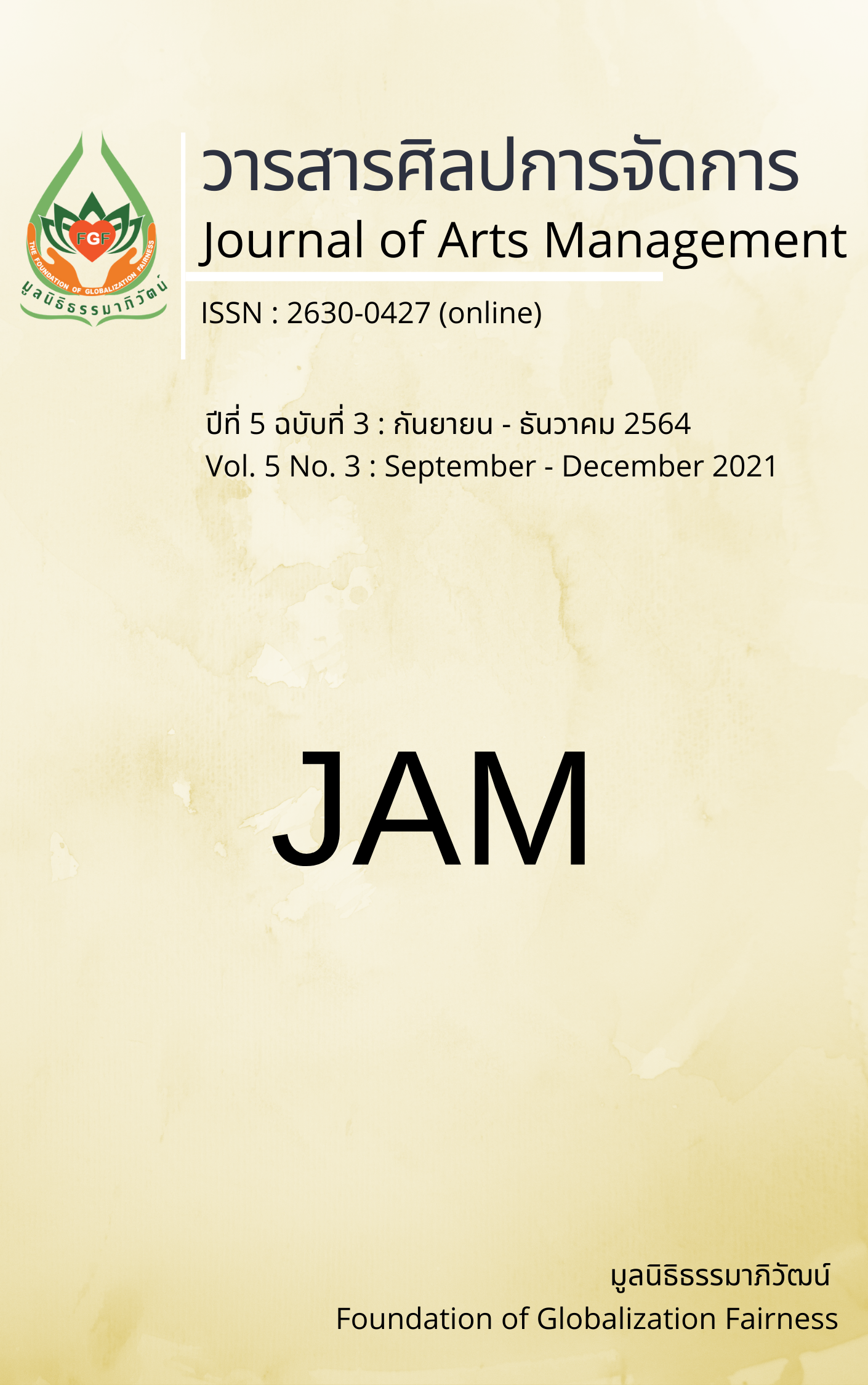ตัวแบบจำลองปัจจัยเชิงสาเหตุของความพึงพอใจทางระบบอิเล็กทรอนิกส์ในการจองห้องพักบนเว็บไซต์ออนไลน์ในประเทศไทย
Main Article Content
บทคัดย่อ
บทความนี้มีวัตถุประสงค์ ดังนี้ 1) เพื่อศึกษาปัจจัยเชิงสาเหตุของความพึงพอใจทางระบบอิเล็กทรอนิกส์ของผู้ใช้บริการในการจองห้องพักบนเว็บไซต์ออนไลน์ในประเทศไทย 2) เพื่อศึกษาอิทธิพลปัจจัยเชิงสาเหตุของความพึงพอใจทางระบบอิเล็กทรอนิกส์ของผู้ใช้บริการ การจองห้องพักบนเว็บไซต์ออนไลน์ในประเทศไทย และ 3) เพื่อสร้างรูปแบบจำลองปัจจัยเชิงสาเหตุของความพึงพอใจทางระบบอิเล็กทรอนิกส์ในการจองห้องพักบนเว็บไซต์ออนไลน์ในประเทศไทย การวิจัยครั้งนี้เป็นการวิจัยแบบผสานวิธี โดยใช้การวิจัยเชิงคุณภาพ และการวิจัยเชิงปริมาณ เครื่องมือที่ใช้เก็บรวบรวมข้อมูล ได้แก่ เก็บข้อมูลจากการสัมภาษณ์ผู้ประกอบการธุรกิจที่พักที่เลือกการขายห้องเว็บไซต์ออนไลน์ ในประเทศไทย จำนวน 12 ราย และเก็บแบบสอบถามออนไลน์จากผู้ใช้บริการการจองห้องพักบนเว็บไซต์ออนไลน์ จำนวน 500 ราย สถิติที่ใช้ในการวิเคราะห์ข้อมูล ได้แก่ วิเคราะห์ทางสถิติด้วยสมการโครงสร้าง และสถิติการวิเคราะห์สหสัมพันธ์แบบเพียร์สัน
ผลการวิเคราะห์สมการโครงสร้างและเส้นทาง พบว่า 1) คุณภาพการให้บริการทางระบบอิเล็กทรอนิกส์ส่งผลทางตรงเชิงบวกต่อความพึงพอใจทางระบบอิเล็กทรอนิกส์ 2) การจัดการข้อร้องเรียนทางระบบอิเล็กทรอนิกส์ส่งผลทางตรงเชิงบวกต่อความพึงพอใจทางระบบอิเล็กทรอนิกส์ 3) คุณภาพของเว็บไซต์ส่งผลทางตรงเชิงบวกต่อความพึงพอใจทางระบบอิเล็กทรอนิกส์ 4) ความพึงพอใจทางระบบอิเล็กทรอนิกส์ส่งผลทางตรงเชิงบวกต่อความภักดีทางระบบอิเล็กทรอนิกส์ 5) คุณภาพการให้บริการทางระบบอิเล็กทรอนิกส์, การจัดการข้อร้องเรียนทางระบบอิเล็กทรอนิกส์, และคุณภาพของเว็บไซต์ มีอิทธิพลทางอ้อมเชิงบวกต่อความภักดีทางระบบอิเล็กทรอนิกส์โดยผ่านความพึงพอใจทางระบบอิเล็กทรอนิกส์ โดยพิจารณาจากค่าพบว่า = 2= 45.36, df= 33,
2/df = 1.375, p-value=0.07425, RMSEA= 0.027, RMR=0.006, SRMR=0.012, CFI=1.00, GFI=0.99, AGFI= 0.96, NFI= 1.00, NNFI=1.00 โดยดัชนีมีความสอดคล้องกับข้อมูลเชิงประจักษ์
Article Details
ทัศนะและความคิดเห็นที่ปรากฏในบทความในวารสารศิลปการจัดการ ถือเป็นความรับผิดชอบของผู้เขียนบทความนั้น และไม่ถือเป็นทัศนะและความรับผิดชอบของกองบรรณาธิการ ยินยอมว่าบทความเป็นลิขสิทธิ์ของวารสารศิลปการจัดการ
เอกสารอ้างอิง
Afshardost, M. (2013). Linking trust, perceived website quality, privacy protection, gender, and online purchase intentions. Journal of Business and Management, 4(13), 63-72.
Anderson, R., & Srinivasan, S. (2003). E-satisfaction and E-loyalty: A contingency framework. Psychology and Marketing, 2(20), 123-138.
Barbara, R L., & Soureli, M. (2006). The antecedents of consumer loyalty in retail banking. Journal of Consumer Behaviour, 1(5), 15-31.
Chansakul, A. (2015). The tourism industry manages the accommodation business online. Bank of Thailand.
Durmus, B., Ulusu, Y., & Erdema, S. (2013). Which dimensions affect private shopping E-customer loyalty. Procedia-Social and Behavioral Sciences, 99, 420-427.
Hair, J. F., Black, W. C., Babin, B. J., Anderson, R. E., & Tatham, R.L. (2006). Multivariate data analysis (6th ed.), Pearson.
Kedah, Z., Ismail, Y., Haque, A., & Ahmed, S. (2015). Key success factors of online food ordering services: An empirical study. Malaysian Management Review, 2(50), 19-36.
Keller, K. L. (1993). Conceptualizing, measuring, and managing customer-based brand equity. Journal of Marketing, 57(1), 1-22.
Kotler, P., & Keller, K. (2016). Marketing management (15th ed.). Pearson Prentice Hall.
Maxham, J. G. (2001). Service recovery’s influence on consumer satisfaction, word-of-mouth, and purchase intentions. Journal of Business Research, 54, 11-24.
Miller, J. L., Craighead, C. W., & Karwan, K. R. (2000). Service recovery: A framework and empirical investigation. Journal of Operations Management, 18, 387-400.
Ministry of Tourism and Sports. (2019, June 9). Ministry of Tourism and Sports. www.mots.go.th
Parasuraman, A., Zeithaml, V., & Malhotra, A. (2005). E-S-QUAL A Multiple-Item scale for assessing electronic service quality. Journal of Service Research, 3(7), 213-233. doi:10.1177/1094670504271156
Ranjbarian, B., Fathi, S., & Zey, R. (2012). Factors influencing on customers’ E-satisfaction: A case study from Iran. Interdisciplinary Journal of Contemporary Research in Business, 9(3), 1497-1511.
Sahadev, S., & Purani, K. (2008). Modeling the consequences of E-service quality. Marketing intelligence and planning, 6(26), 605-620. doi:10.1108/02634500810902857
Suksawang, P. (2014). Principles of structural equation model analysis. Journal Narathiwat Rajanagarindra University, 2(6), 136-145.
Uon, V. (2010). Research and business information retrieval. Sripatum University.
Wong, W. P. (2014, March). The impact of trustworthiness and customer e-loyalty and e-satisfaction. International Journal of Academic Research in Business and Social Sciences, 3(4), 390-408.


